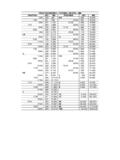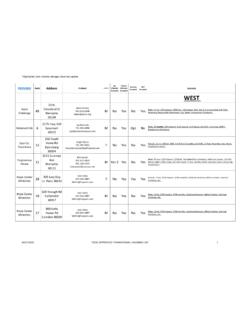Transcription of Learning Styles Again: VARKing up the right tree!
1 Learning Styles Again: VARKing up the right tree! Neil Fleming, Educational Developer and David Baume, FSEDA, Higher Education Consultant Fleming, N., and Baume, D. (2006) Learning Styles Again: VARKing up the right tree!, Educational Developments, SEDA Ltd, Issue , Nov. 2006, p4-7. Introduction This article was developed in conversations (face to face and via email) between David Baume PhD FSEDA, higher Education Consultant, and Neil Fleming, the designer of the VARK questionnaire and helpsheets. Understanding how we learn Students and teachers need a starting place for thinking about, and understanding, how they learn.
2 Self-knowledge is a good start. How to get that self-knowledge? Inventories can be useful. Initially, it doesn't much matter which inventory we use. Why not? Because a Learning style is not a set of scores on some inventory, or a set of alphabetic symbols, or paragraphs of descriptors with labels. A Learning style is, rather, a description of a process, or of preferences. Any inventory that encourages a learner to think about the way that he or she learns is a useful step towards understanding, and hence improving, Learning . VARK above all is designed to be a starting place for a conversation among teachers and learners about Learning .
3 It can also be a catalyst for staff development - thinking about strategies for teaching different groups of learners can lead to more, and appropriate, variety of Learning and teaching. One proviso should be made about the VARK inventory. It is, technically, not a Learning Styles questionnaire, as it provides feedback only on one's preferred modes for communicating. These 'modal preferences for Learning ' are only a small part of what most theorists would include in a complete package deserving to be called a ' Learning style'. Some learners already know a lot about the way they learn, and need no help from any inventory or questionnaire.
4 For others, doing the VARK questionnaire again and again over time is a worthwhile exercise, even though - maybe because - the scores may vary. VARK works when people find it useful. The origins of VARK For nine years I was one of Her Majesty's school inspectors in the New Zealand education system. During this time I watched some 9000 classes. I was puzzled when I observed excellent teachers who did not reach some learners, and poor teachers who did. When I moved to Lincoln University to work in staff development, I decided to try to solve this puzzle. There are, of course, many reasons for what I observed.
5 But one topic that seemed to hold some magic, some explanatory power, was preferred modes of Learning , 'modal preferences'. Some parts of a Learning preference are comparatively difficult for an individual to change, or for an education system to respond to - for example, preferred time of day to study, or preferred time for food intake, or motivation. But attention to preferred Learning modes allows flexibility for students and teachers to modify their behaviour, if not their preference. It seems to me that our preferences are part of who we are. They inform how we approach things.
6 We often have quite strong preferences for such things as cars, colours, food and partners. So why not look into our preferences for the ways in which we learn? The main ideas and sources that informed VARK were my prior experiences and observations, and working with students and teachers at Lincoln University who provided my laboratory and practicum. My main current ideas about preferred Learning modes include: modal preferences influence individuals' behaviours, including Learning modal preferences are not fixed, but they are stable in the medium term both students and teachers can reliably identify and provide examples of their use of modality preferences in Learning preferences can be matched with strategies for Learning .
7 There are Learning strategies that are better aligned to some modes than others. Using your weakest preferences for Learning is not helpful; nor is using other students' preferences information that is accessed using strategies that are aligned with a student's modality preferences is more likely to be understood and be motivating the use of Learning strategies that are aligned with a modality preferences is also likely to lead to persistence Learning tasks, a deeper approach to Learning , active and effective metacognition knowledge of, and acting on, one's modal preferences is an important condition for improving one's Learning .
8 I could produce a similar list for teachers' modality preferences and their influence on students' Learning . But I am not a theorist. The development of VARK - and the name I noticed that, in response to a question such as 'How do I get ', people gave directions in different ways. I wondered if different people prefer to be told how to get there in different ways - being shown a printed map, having a map sketched for them, being told, being given written instructions, being physically taken there. So I began with a question about this. Other questions came from my work with students.
9 I tested these questions on students whose preferences I knew from discussions and from examples of their note-taking and Learning patterns. After a couple of years I had 13 questions. I called the questionnaire VARK. It could have been KRAV or VRAK. I learned much later that VARK is Dutch for pig, and I could not get a website called because a pet shop in Pennsylvania used it for selling aardvarks - earth pigs! VARK is an acronym for Visual, Aural, Read/write and Kinesthetic. VAK inventories had been around for years. What was new in my work was a second 'visual' modality for Read/write learners.
10 From what I read and observed, it seemed obvious that some students had a distinct preference for the written word whilst others preferred symbolic information as in maps, diagrams, and charts. These two preferences were not always found in the same person. There is more acceptance of this distinction today than in the 1980s. Using VARK Users complete the questionnaire online or on paper. They can have more than one answer per question, so they get a profile of four scores - one for each modality. That begins a process of thinking about how they prefer to learn. VARK is a catalyst for metacognition, not a diagnostic or a measure.









